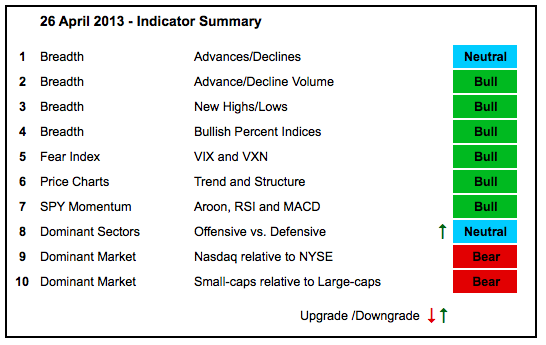With a big rebound this week, the indicator summary remains firmly in the bullish camp. The NYSE AD Line hit a new high. The NYSE and Nasdaq AD Volume Lines also hit new highs. The Consumer Discretionary SPDR (XLY) and the Finance SPDR (XLF) led the offensive sectors this week and challenged their 52-week highs.


- AD Lines: Neutral. The Nasdaq AD Line broke support and then surged right back to the early April high. Tough call here, but I am going to consider the support break bearish for a few more days. The NYSE AD Line hit a new high so no weakness there.
- AD Volume Lines: Bullish. The Nasdaq and NYSE AD Volume Lines surged to new highs and remain in bull mode.
- Net New Highs: Bullish. Nasdaq and NYSE Net New Highs remain strong, but below the levels seen in early April. Watch the cumulative lines as they hold above their 10-day EMAs.
- Bullish Percent Indices: Bullish. Eight of the nine Bullish Percent Indices are above 50%. The Energy SPDR (XLE) is below 50%.
- VIX/VXN: Bullish. The S&P 500 Volatility Index ($VIX) and the Nasdaq 100 Volatility Index ($VXN) fell back this week and affirmed resistance at 20.
- Trend-Structure: Bullish. SPY and MDY surged to challenge their 52-week highs. QQQ is also challenging its 2013 high. IWM and DIA are lagging because they fell a little short. Nevertheless, the trends are up with the April lows marking first support.
- SPY Momentum: Bullish. RSI dipped into the 40-50 zone for a big test. MACD(5,35,5) turned down, but has yet to turn negative. The Aroon oscillator turned negative, but has yet to break below -50.
- Offensive Sector Performance: Neutral. The Consumer Discretionary SPDR (XLY) and Finance SPDR (XLF) are doing their part by surging to their early April highs. The Industrials SPDR (XLI) and Technology SPDR (XLK) are lagging though.
- Nasdaq Performance: Bearish. The $COMPQ:$NYA ratio fell from September to late January and then flattened the last three months.
- Small-cap Performance: Bearish. The $RUT:$OEX ratio bounced this week, but remains in a downtrend since mid March.
- Breadth Charts (here) and Inter-market charts (here) have been updated.
This commentary and charts-of-interest are designed to stimulate thinking. This analysis is
not a recommendation to buy, sell, hold or sell short any security (stock ETF or otherwise).
We all need to think for ourselves when it comes to trading our own accounts. First, it is
the only way to really learn. Second, we are the only ones responsible for our decisions.
Think of these charts as food for further analysis. Before making a trade, it is important
to have a plan. Plan the trade and trade the plan. Among other things, this includes setting
a trigger level, a target area and a stop-loss level. It is also important to plan for three
possible price movements: advance, decline or sideways. Have a plan for all three scenarios
BEFORE making the trade. Consider possible holding times. And finally, look at overall market
conditions and sector/industry performance.

About the author:
Arthur Hill, CMT, is the Chief Technical Strategist at TrendInvestorPro.com. Focusing predominantly on US equities and ETFs, his systematic approach of identifying trend, finding signals within the trend, and setting key price levels has made him an esteemed market technician. Arthur has written articles for numerous financial publications including Barrons and Stocks & Commodities Magazine. In addition to his Chartered Market Technician (CMT) designation, he holds an MBA from the Cass Business School at City University in London.
Learn More





